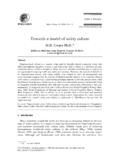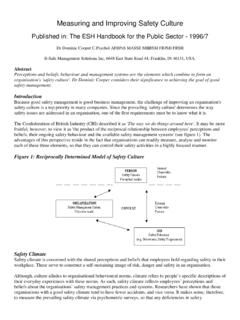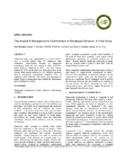Transcription of Surfacing your safety culture - Behavior-based safety
1 Major Hazard Commission at the Federal Ministry of Environment: Human Factors Conference 4-6th March 2002 at Ev. Akadamie, Loccum, Germany. Published in the Proceedings. ISBN 3-8172-4302-2. Surfacing your safety culture Prof. Dr. Dominic Cooper FIOSH FRSH. Dept of Applied Health Science Indiana University, Bloomington, USA. (Now with BSMS Inc, Franklin, IN 46131). Abstract In recent years, the results of public inquiries into large scale disasters has highlighted the important role of the corporate atmosphere or culture ' whereby safety is understood to be, and is accepted as, the number one priority (Cullen, 1990). This has led to many companies and industries giving high priority to improving their safety culture ' without really knowing what it is, or whether or not they have achieved an improvement.
2 Historically, this situation was caused by the lack of a universally accepted definition of safety culture or measurement methodology. Cooper (2000) offers a practical triadic model to overcome both of these issues to facilitate the measurement and quantification of safety culture . Cooper's model asserts that safety culture can be measured by examining the interactions between safety management systems, people's perceptions about safety and people's actual safety related behaviour, by using safety Management System Audits, safety Climate Surveys and Behavioural safety Systems. The model predicts that an improvement intervention aimed at any one of these three components will exert a reciprocal effect on the other two ( The quality of the company's safety management system will exert an effect on people's safety behaviour and their attitudes and beliefs about safety ).
3 For example, Townsend (2001) recently completed a study in heavy construction based on 700 million man- hours. He showed that, within the context of a structured safety management system (Organisation), the top 25% of safety performers habitually (behaviour) intervened to correct unsafe acts/conditions and praise safe working, and considered safety management a moral duty (attitude and beliefs) to be taken seriously. In another study based on 110 million man- hours of petrochemical construction, it was identified that improving safety performance by 50% was associated with productivity improvements averaging 12% (Stewart & Townsend, 2000). This demonstrates that effective safety management can increase productivity as well as profitability (Levitt & Samelson, 1987).
4 However, this is dependent on companies optimising the balance between the effort and resources they allocate to developing safety systems, promoting safe behaviour and encouraging positive safety values and beliefs. This paper presents real world data using Cooper's reciprocal safety culture model to demonstrate how companies can identify exactly where best to focus their efforts and resources in pursuit of their safety goals. Introduction The term safety culture ' first made its appearance in the 1987 OECD Nuclear Agency report (INSAG, 1988) on the 1986 Chernobyl disaster. Gaining international currency over the last decade, it is loosely used to describe the corporate atmosphere or culture in which safety is understood to be, and is accepted as, the number one priority (Cullen, 1990).
5 Unless safety is the dominating characteristic of corporate culture , which arguably it should be in high-risk industries, safety culture is a sub-component of corporate culture , which alludes to individual, job, and organizational features that affect and influence health & safety . As such the dominant corporate culture and the prevailing context such as downsizing and organizational restructuring ( Pierce, 1998) will exert a considerable influence on its development and vice-versa as both inter-relate and reinforce each other ( Williams, 1991). This latter point illustrates that safety culture does not operate in a vacuum: It affects, and in turn is affected by, other operational processes or organizational systems.
6 This becomes more apparent when theoretical models of accident causation are examined (See Cooper 1998 for a detailed overview). The most influential of these is Heinrich's Domino model (See Heinrich et al. 1980; Weaver,1971; Adams, 1976 ; Reason,1990). While Heinrich concluded that the key domino was that pertaining to unsafe acts, Weaver (1971) focused on symptoms of operational error (management omissions) that interact with unsafe acts and/or conditions. Adams (1976) emphasised that operational errors were caused by the Management structure; Management's objectives; the Synchronisation of the work flow system; and How operations were planned and executed. In turn these operational errors caused 'tactical errors' (unsafe acts or conditions).
7 Reason & Wreathall, (Cited in "Der Human Factor in der Sicherheitspraxis der Proze industrie- Aktivierung der Sicherheitsressource Mensch durch Beteiligung". 1. Major Hazard Commission at the Federal Ministry of Environment: Human Factors Conference 4-6th March 2002 at Ev. Akadamie, Loccum, Germany. Published in the Proceedings. ISBN 3-8172-4302-2. Reason 1993) aligned the domino model to a parallel five element production model and identified how and where latent and active safety failures (termed pathogens ) might be introduced into organizational systems (See figure 1). Both latent and active failures are introduced by organisational or managerial factors ( top-level decision-making), but individuals ( psychological or behavioral precursors).
8 Trigger the active failures. Like Adams before him, therefore, Reason shifts the main focus of accident prevention away from unsafe acts and more onto the organization's management systems. Figure 1: Adaptation of Reason & Wreathall's pathogen model Production Systemic Accident Factors Pathogens Factors High-level Latent Failures Fallible Source decision makers Strategic level decisions Types Line Latent Failures Line management management Function Tactical level implementation deficiencies Preconditions: Latent Failures Preconditions: People, Technology Operational level for unsafe acts Condition & Equipment Tokens Synchronised Active Failures Unsafe acts Human productive Behavioural level Error activities Defences & Failed or Active Failures protective absent measures Defensive level defences Loss Accident Defining safety culture Although numerous definitions of safety culture abound in the academic literature, the one most widely used to guide British industry was developed by the Advisory Committee for safety on Nuclear Installations on behalf of the British Health and safety Commission (1993) which states that safety culture is.
9 The product of individual and group values, attitudes, competencies, and patterns of behavior that determine the commitment to, and the style and proficiency of, an organizations health & safety management. Organizations with a positive safety culture are characterised by communications founded on mutual trust, by shared perceptions of the importance of safety , and by confidence in the efficacy of preventative measures'. One aspect overlooked by all concerned was the lack of clarity about the safety culture product'. This caused confusion amongst both practitioners and academics as to what a safety culture is. Due to the lack of any concrete definition of this product', many practitioners focused their efforts on improving peoples shared values, beliefs and attitudes in the hope that this was improving their company's safety culture .
10 This approach was reinforced by academics who developed safety climate surveys as a surrogate measure of safety culture ( Flin et al, 1996; Lee, 1998). Although they are useful tools designed to encourage participation in safety by gauging people's opinions about things like the extent of risk taking, compliance with procedures etc., as well as safety attitudes, such surveys only offer a partial view of a company's safety culture (See Guldenmund 2000). A perusal of safety research ( ASCNII, "Der Human Factor in der Sicherheitspraxis der Proze industrie- Aktivierung der Sicherheitsressource Mensch durch Beteiligung". 2. Major Hazard Commission at the Federal Ministry of Environment: Human Factors Conference 4-6th March 2002 at Ev.)



